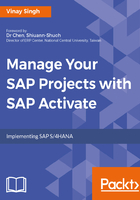
Start with best practices
Best practices is one the three pillars of SAP Activate (as discussed in Chapter 1, Introduction to SAP S/4HANA). Delivering best practices via SAP Activate methodology serves SAP's vision of increased value proposition and Time to Value (TtV) (TtV is the time between a business request and the initial delivery of that request) for customers. Customers can start fast, build smart, and run simple while continuously innovating. It also makes the onboarding of new solutions such as SAP S/4HANA simple and fast, by providing trial offerings with sample data. SAP Activate contains best practices for the S/4HANA Cloud edition as well as an on-premise edition. In SAP S/4HANA, following SAP Activate, we can take advantage of a Model Company and use it as a baseline during the fit/gap sessions to validate our requirements against it.
The Model Companies are SAP Best Practices and ready-to-use reference solutions embedded in the product (SAP S/4HANA) and shipped with a predefined master data and organizational data that allow SAP customers to jump-start the implementation. The Model Companies for SAP S/4HANA replaces the SAP Best Practices content, including the content provided with the Word template.
The Model Companies include the business process documentation (for example, business process definition, solution documentation, configuration blocks, and process diagrams) for the SAP S/4HANA implementation that is provided via the SAP Activate content integrated with SAP Solution Manager 7.2. The SAP Model Companies can be adjusted to the customer needs via configuration activities.
SAP provides two types of configuration activities:
- The user-guided configuration: This configuration is used to configure the chosen SAP Best Practices to add and adapt some "uncritical" settings, for example, the value of a PO approval. This kind of change does not change the actual business processes.
- The expert configuration: To adopt SAP Model Companies and to add additional customer-specific processes. The SAP Model Companies are prerequisites for fast and agile implementation. They allow you to start the project immediately and build the solution quickly as long as you stay close to the SAP standard solution. Model Companies are the ultimate form of standardization for a specific line of business or industry solution.
- Cloud-ready
For non-S/4Hana solutions (as of now), SAP provides systems and content on demand and Ready-to-Run as per the project need. These contents are delivered as preassembled packages to enable the customer to:- Jumpstart projects with redeployed, preassembled, and pretested templates from SAP
- Accelerate development by eliminating common and manual configurations
- Defer the decision on choosing the final infrastructure (cloud or premise) and initiate work in the SAP-hosted cloud
- Adopt a solution to project needs using common organizational structures, preloaded data, content enhancement, and more
With these preassembled packages, the customer leverages accelerated development and implementation, reduces time to value, can be agile and achieve faster innovation. As discussed in the last section about a Model Company via SAP Activate, you get a flexible deployment option of the preassembled Model Company (In cloud or on-premise).
A customer can choose from the following Model Companies:
- A clean slate Model Company
- A qualified Model Company:

The service building blocks of an SAP Model Company are as follows:
- Best practices: Methodologies and step-by-step approaches combining knowledge of customer projects.
- Preconfigured end-to-end processes: End-to-end processes tailored to your industry and line of business with preconfigured steps for operating the business with SAP software.
- SAP Solution Manager documentation: Business process documentation ready to use for discovery and fit/gap analysis.
- Industry references architecture: Aligned with reference architecture for a domain.
- Engineered services: Accelerators for adoption and onboarding.
- Sample data: Sample transactional and master data for demo purpose.
- SAP software: SAP S/4HANA, SAP success factors, and other industry solutions.
- Validate solution: Validate to best practices with fit/gap workshop and capture data.
In the explore phase of the SAP Activate methodology, a solution validation workshop is encouraged to verify that the solution scenarios meet the business needs, and at the same time, backlogs are captured and Delta design can be done accordingly. This gives accelerated time to value through content reuse and focus on differentiating capabilities. - Premium engagement ready: Build and run fully supported via SAP control centers. Customers with SAP MaxAttention and SAP Active embedded agreements will find assistance for the use of control centers and other related services in the SAP Activate methodology.
The following diagram shows the engagement type at various phases of the SAP Activate methodology. Each phase is well connected via SAP support to keep innovating and at the same time making sure that operations are not affected:

- Modular, scalable, and agile: With SAP Activate, the projects are structured to deliver solutions directly. It is an agile implementation methodology that will help the customer to adapt quickly to the rapid development cycle. To facilitate customer co-innovation, the whole approach has been modularized, with the full support for initial deployment and continuous business innovation. The methodology is highly scalable and supports projects with vivid scope and complexity. Its flexible framework allows us to provide prescriptive guidance for any SAP project.
- Quality built-in: Identify risk early with a total quality approach. Though ASAP and SAP launch had concepts of quality gates, with SAP Activate, formal risk and quality management with a structured quality management plan and pre-defined Q-gates, are built into the project from the start.